SaaS Email Sequences: Secrets for Better Engagement and Retention
Recently, my friend, who has been working as an IT specialist for the last 10 years, decided to start his own business and launched his web app. Leaving a stable job to become an entrepreneur and not getting the traction you hope for can be stressful, so he reached out to me for help on how to increase brand awareness.
The SaaS environment is completely different from the physical products environment. In fact, each year, 22 percent of SaaS companies fail due to not being able to retain or find customers.
It's hard to retain customers, especially at first when you need revenue the most. Social media and SEO are valuable marketing channels, but they take time to develop. On the other hand, email marketing is direct, and you can start immediately.
So, here are the most effective SaaS email sequences that will help you throughout the entire customer journey.
Let's start with the basics: What does email sequence mean for SaaS companies?
An email sequence in the context of SaaS (Software as a Service) refers to a series of automated emails sent to users or prospects over a set period of time to achieve specific goals. These goals can include nurturing leads, onboarding new users, engaging existing customers, or driving conversions such as trial sign-ups or purchases.
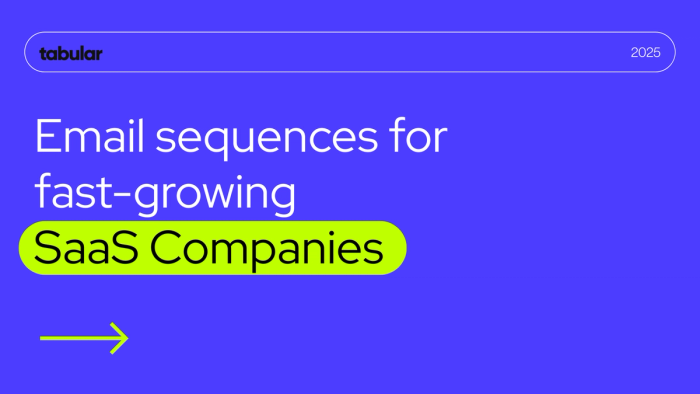
Key characteristics of a SaaS email sequence:
- It is a pre-planned, timed series of emails triggered by specific user actions, such as signing up for a trial, downloading resources, or being added to a lead list.
- Emails are sent automatically at scheduled intervals to guide the recipient step-by-step, similar to a multi-stage conversation.
- Personalization is often included to address the specific needs or pain points of the recipient, improving engagement and response rates.
- Different types of sequences exist, including cold email sequences targeting prospects who haven’t shown interest yet, and onboarding sequences aimed at helping new users get value from the product early, reducing churn.
- The sequence often progresses logically, starting from introduction or welcome emails, moving through educational content about features and benefits, and ending with calls to action to convert or upgrade.
- Automation tools manage sending, tracking engagement (opens, clicks, replies), and adjusting the flow based on recipient actions.
In SaaS marketing and user engagement, well-crafted email sequences help companies efficiently nurture relationships, demonstrate product value, and ultimately increase customer retention and sales.
Best Email Sequences for SaaS Companies
Email is the most direct communication channel between you and your customers. In fact, 73% of consumers consider customer experience a key factor in purchasing decisions, second only to price and product quality. This means your connection with your customers is more important than your entire marketing plan.
But how do you achieve this connection when you're communicating with people you know very little about, apart from their interest in your product? The answer lies in automated email sequences based on customer profiles and email mapping.
Here are the most common and effective SaaS email sequences you can use in 2025:
Onboarding Sequence for SaaS Companies
An onboarding sequence is a structured series of emails designed to guide new users through their initial experience with the software, helping them quickly understand the product’s value and use key features effectively.
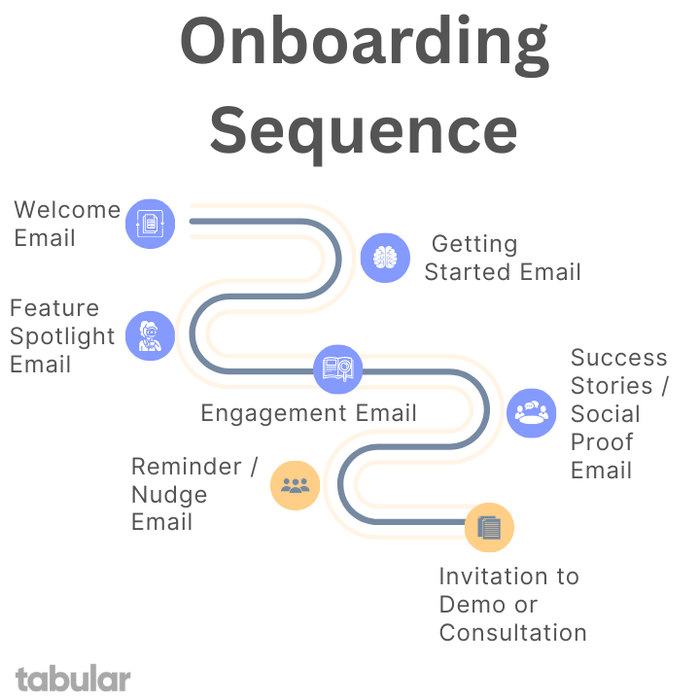
- Welcome emails have an average open rate of 50%.
- They are 86% more effective than standard promotional emails.
- A strong onboarding flow engages users early, reduces churn (the number of customers who stop doing business with your company within a given period) , and increases the likelihood of conversion from free trials or sign-ups to paying customers.
Typical SaaS Onboarding Email Sequence Structure
1. Welcome Email
- Greet the user warmly.
- Thank them for signing up.
- Provide clear next steps (e.g., “Complete your profile” or “Start your first project”).
- Include links to helpful resources, tutorials, or guides.
2. Getting Started Email
- Offer a simple guide or short tutorial.
- Highlight key features to explore for quick wins.
- Encourage users to take the first meaningful action inside the product.
3. Feature Spotlight Email
- Introduce and explain a core or unique feature.
- Show how it solves common problems or improves productivity.
- Use visuals like screenshots, GIFs, or short videos to demonstrate.
4. Progress Check / Engagement Email
- Ask how their onboarding is going.
- Offer help or link to support resources.
- Include FAQs or guides to remove blockers.
5. Success Stories / Social Proof Email
- Share customer testimonials or case studies.
- Show examples of how other users achieved success with the product.
- Build trust and demonstrate real-world value.
6. Reminder / Nudge Email
- Remind users to complete onboarding steps they’ve missed.
- Highlight benefits they’re missing out on.
- Include a clear call to action to re-engage.
7. Invitation to Demo or Consultation (Optional)
- Offer a chance to book a live demo or call with the support/sales team.
- Great for higher-touch SaaS products or B2B platforms.
Best Practices for SaaS Onboarding Emails
- Personalize based on user behavior, signup source, or profile.
- Space emails over several days or weeks to avoid overwhelming users.
- Keep emails short and actionable with one main goal per email.
- Use visuals to make explanations clearer and more engaging.
- Make sure emails are mobile-friendly.
- Provide easy access to support and knowledge bases.
Compared to traditional email marketing templates, SaaS emails are designed completely differently. No matter what sequence you use, brand consistency and professionalism are the most important factors for your brand’s visibility. If you are new to designing HTML email templates, don’t forget to check Tabular’s free email templates before running your first marketing campaign.
Create your template using our email template builder.
SaaS Free Trial Email Sequences
A trial-to-customer email sequence for SaaS companies is a targeted series of emails designed to convert free trial users into paying customers by demonstrating value, nudging key actions, and reducing friction throughout the trial period.
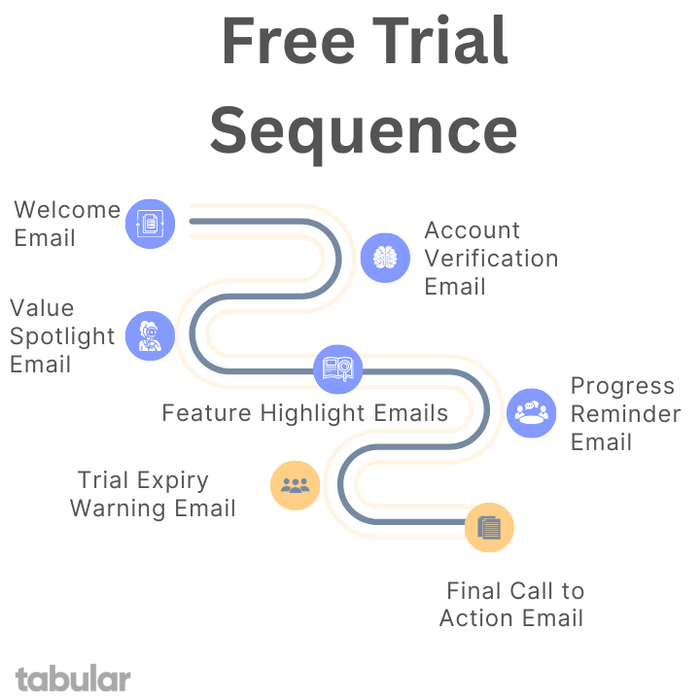
- Average SaaS trial-to-paid conversion rates range around 14-25% for B2B and 2-10% for B2C.
- Top performers can achieve 25-50% conversion through optimized onboarding and engagement.
- Companies like Slack, Zoom, Dropbox, and Canva excel at this by focusing on user experience and clearly demonstrating value during trials.
Key Components of a Trial-to-Customer Sequence
1. Welcome & Orientation Email
- Sent immediately after trial signup.
- Thanks the user for joining.
- Provides clear onboarding steps and resources to get started quickly.
2. Value Activation Email
- Sent within the first few days.
- Focuses on helping users achieve the "aha moment" or key value proposition.
- Encourages completing actions that unlock product benefits.
3. Feature Highlight Emails
- Sent during the mid-trial period.
- Showcases valuable and often underused features.
- Includes tutorials or demos to increase engagement.
4. Progress Reminder Email
- Checks in on trial progress.
- Offers support or resources to users who seem inactive or stuck.
- Reinforces the benefits of the product and the value of upgrading.
5. Trial Expiry Warning Emails
- Sent close to trial expiration (e.g., 3 days and 1 day before).
- Communicates the urgency to upgrade to maintain access.
- Often includes incentives like discounts or extended demos.
6. Final Call to Action Email
- Sent immediately after trial expiration.
- Summarizes the benefits, recent activity, and prompts upgrading.
- May offer last-chance deals or personal outreach options.
Trial to Customer Email Sequences Best Practices to Maximize Conversion
- Prompt upgrades early and often, not just at trial end.
- Guide users quickly to meaningful value to motivate continued use.
- Use checklists, progress bars, or in-app nudges to drive completion of key actions.
- Personalize emails based on user behavior and engagement level.
- Offer multi-channel support (e.g., chat, webinars, tutorials) to reduce friction.
- Collect feedback from non-converting users to identify and fix pain points.
This structured email approach helps SaaS companies effectively nurture trial users, making the upgrade decision clear and compelling.
MQL to SQL Email Sequence for SaaS Companies
An MQL to SQL email sequence for SaaS companies is a targeted communication flow designed to nurture Marketing Qualified Leads (MQLs)—who have shown interest but aren't yet ready to buy—into Sales Qualified Leads (SQLs), who are ready for direct sales engagement.
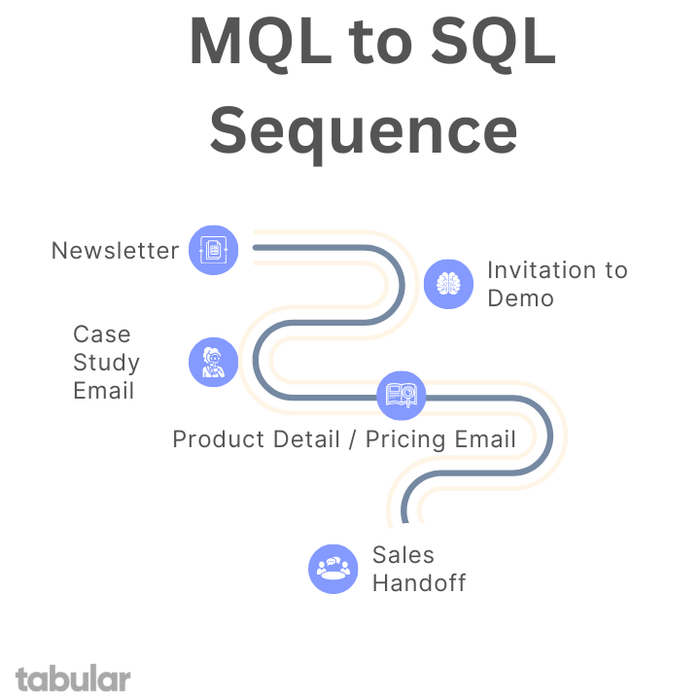
This sequence helps move leads through the buying journey by providing the right saas content and touchpoints based on their interest level and readiness to purchase.
- MQL (Marketing Qualified Lead): A prospect showing interest through actions such as downloading resources, attending webinars, or visiting pricing pages.
- SQL (Sales Qualified Lead): A prospect vetted by marketing and sales teams, demonstrating buying intent, such as requesting demos or engaging in personalized consultations.
Typical MQL to SQL Email Sequence for SaaS
1. Engagement Email
- Sent soon after a lead becomes an MQL.
- Includes personalized content like relevant blog posts, ebooks, or case studies.
- Focuses on educating the lead and addressing pain points.
2. Invitation to Demo or Webinar
- Offers the opportunity to see the product in action.
- Helps move leads from research to consideration by providing an interactive experience.
3. Use Case or Case Study Email
- Shares success stories from similar companies or use cases.
- Builds trust by showing real-world benefits.
4. Product Detail / Pricing Email
- Provides clear information on features, pricing plans, and ROI.
- Helps prepare leads for decision-making.
5. Qualification Check / Sales Handoff Email
- Asks qualifying questions or offers a call with sales.
- Signals readiness for a sales conversation.
Best Practices
- Align marketing and sales teams to define clear MQL and SQL criteria.
- Use lead scoring to identify when a lead should move from MQL to SQL.
- Personalize emails based on lead behavior and content engagement.
- Automate timely follow-ups to maintain momentum.
- Facilitate a smooth handoff from marketing nurturing to sales outreach, with timely notifications and shared CRM updates.
This sequence ensures SaaS companies focus sales efforts on leads most likely to convert, improving efficiency and increasing the chances of closing deals.
Sales Funnel Email Sequence for SaaS Companies
A sales funnel email sequence for SaaS companies is designed to guide leads through the various stages of their buyer journey—from awareness to consideration, and finally to decision—by nurturing them with targeted, relevant content and calls to action (CTAs) that drive conversion.
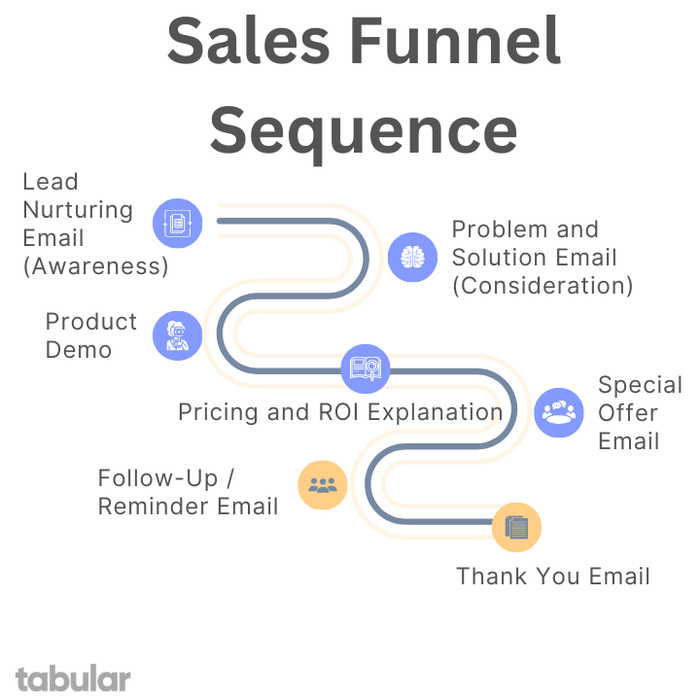
Typical SaaS Sales Funnel Email Sequence
1. Lead Nurturing Email (Awareness Stage)
- Introduce the product and its unique value proposition.
- Offer educational content like ebooks, industry reports, or blog posts that solve leads' pain points.
- Build trust and brand authority.
2. Problem and Solution Email (Consideration Stage)
- Address specific challenges prospects commonly face.
- Explain how the SaaS product solves these problems with feature highlights and benefits.
- Include testimonials or case studies for social proof.
3. Product Demo or Webinar Invitation
- Encourage prospects to see the product in action via a live demo or recorded webinar.
- Helps move them closer to purchase by showing real-world application and ROI.
4. Pricing and ROI Explanation
- Share pricing plans clearly along with the return on investment or cost-benefit.
- Include comparisons with competitors or show total cost of ownership savings.
5. Urgency and Special Offer Email
- Create urgency with limited-time offers, discounts, or bonuses.
- Encourage immediate action with deadline-driven CTAs.
6. Follow-Up / Reminder Email
- Send a polite nudge if leads haven’t acted.
- Include a link to schedule a call or ask questions.
- Provide additional content such as FAQs or relevant blog posts.
7. Closing and Thank You Email
- Acknowledge the interaction regardless of conversion.
- Keep the door open for future engagement.
Best Practices
- Personalize content based on lead data and behavior.
- Keep emails concise with one clear CTA per message.
- Use automation to deliver emails timed to user actions or engagement signals.
- Mix educational content, social proof, and direct sales messages for balanced persuasion.
- Track responses and adjust sequences dynamically.
Example Subject Lines and Emails
- Day 1: “Transform Your Team’s Workflow with [Product Name]”
- Day 3: “Struggling with [Problem]? Here’s the Answer”
- Day 7: “See How [Client Name] Boosted Productivity by 30%”
- Day 10: “Pricing Plans That Fit Your Needs”
- Day 14: “Limited Time Offer: Save 20% Today”
This email sequence format helps SaaS companies systematically educate, engage, and convert leads through each stage of the sales funnel, increasing the effectiveness of their marketing and sales efforts.
Lost Customer Email Sequence for SaaS Companies
Losing a customer is sad, but did you know that returning customers spend 67% more on average than new customers? Email marketing is a great tool for re-engaging with your old users.
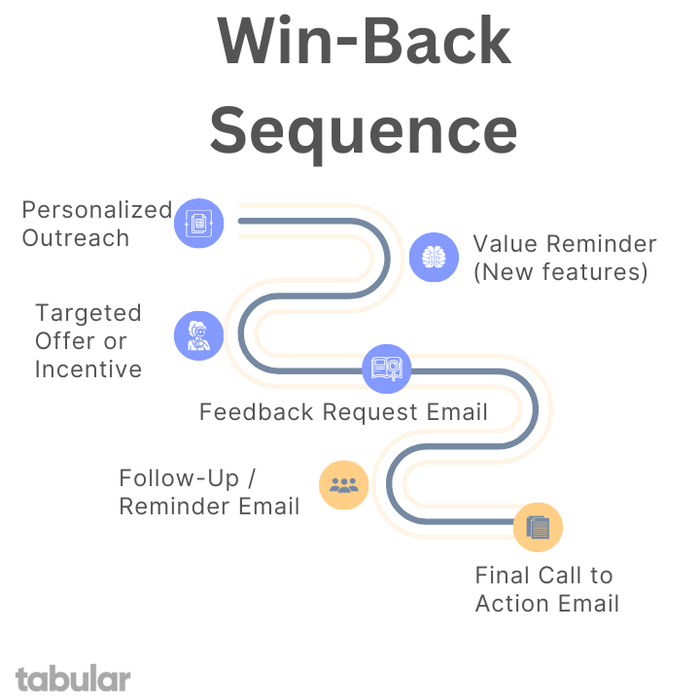
A lost customer email sequence for SaaS companies is a targeted series of emails designed to win back customers who have churned, stopped using the product, or downgraded their subscription. The goal is to re-engage these users by reminding them of the product’s value, addressing their reasons for leaving, and providing incentives or support to come back.
Key Components of a Lost Customer Email Sequence
1. Simple, Personalized Outreach
- Short, human-like emails asking if the customer still needs help or if their challenges are solved.
- Examples: “Are you still looking for a solution to [pain point]?” or “Do you still want to achieve [goal]?”
2. Value Reminder
- Highlight new features, updates, or improvements since their departure.
- Remind them why they signed up in the first place and what they are missing.
3. Targeted Offer or Incentive
- Provide discounts, extended trials, or exclusive calls with experts to encourage return.
4. Feedback Request
- Ask why they left or what could improve, showing the company values their input.
- Helps tailor future communications and product development.
5. Final Call with Clear CTA
- A straightforward message with a clear call to action, such as “Reactivate your account” or “Schedule a call.”
Best Practices
- Keep emails short, friendly, and focused on one clear message per email.
- Use plain text to appear personal and avoid looking like mass marketing.
- Space emails over several weeks to avoid overwhelming the recipient.
- Capture key data during the sales process to personalize outreach effectively.
- Use minimalist designs emphasizing readability and single CTAs.
Example Sequence Flow
- Email 1: “Are you still interested in [product/service/feature]?”
- Email 2: “Check out what’s new at [Product] since you left”
- Email 3: “Here’s a special offer to welcome you back”
- Email 4: “Can we help you achieve [goal]? Let us know”
- Email 5: “Last chance to reactivate your account and save”
This approach makes win-back campaigns efficient and personal, helping SaaS companies reduce churn, recover revenue, and maintain a strong customer base.
Lead Nurture Email Sequence for SaaS Companies
A lead nurture email sequence for SaaS companies is a series of emails aimed at educating and engaging potential customers over time to gradually move them closer to making a purchase decision. This sequence focuses on building trust, showcasing value, and keeping the brand top-of-mind without being overly aggressive.

Typical SaaS Lead Nurture Email Sequence
1. Greetings and Brand Introduction
- Introduce your company and what you offer.
- Explain who you help and how.
- Build initial rapport.
2. Provide Free Value
- Share a highly relevant piece of content that addresses the lead’s pain points.
- Examples: blog posts, whitepapers, ebooks, webinars, or industry insights.
3. Feature Introduction
- Highlight key product features or services with practical examples.
- Include videos or demos showing the product in action.
4. Social Proof and Case Studies
- Share customer success stories from companies similar to the lead’s industry or role.
- Show measurable outcomes or testimonials to build credibility.
5. Competitor Comparison and Differentiation
- Provide comparisons that highlight how your solution outperforms competitors.
- Emphasize your unique value propositions.
6. Industry Insights and Trends
- Deliver summary analyses, statistics, or trends relevant to the lead’s business.
- Position your product as aligned with industry best practices.
7. Address Objections
- Identify common concerns or objections prospects raise.
- Provide logical, data-driven responses that alleviate doubts.
8. Continue Sharing Value
- Keep offering useful content until the lead converts or opts out.
- Softly remind that you are available to help or demo your product.
Why Lead Nurture Email Sequence Works for SaaS Companies
- Keeps leads gently engaged over time without excessive pressure.
- Provides educational resources that help leads understand their challenges and solutions.
- Builds confidence and trust through social proof and data.
- Encourages leads to think of your solution as the best fit when ready to buy.
This approach nurtures leads thoughtfully through their buyer journey, gradually moving them toward becoming Marketing Qualified Leads (MQLs) or paying customers.
Renewal Email Sequence for SaaS Companies
A renewal email sequence for SaaS companies is a strategic series of emails sent before, during, and after a subscription’s expiration to encourage customers to renew. The sequence balances clear communication, reminders, value reinforcement, and user empowerment to maintain high retention rates and reduce churn.

Typical SaaS Renewal Email Sequence
1. Renewal Reminder Email (7 to 14 days before expiration)
- Friendly and clear notification that the subscription is about to expire.
- Emphasizes ease of renewal with a direct call-to-action (CTA) like "Renew Now."
- Includes contact options for questions or plan changes.
2. Auto-Renewal Notification Email
- For customers on auto-renew, a heads-up that renewal will happen soon automatically.
- Details on renewal date and how they can change or cancel if needed.
- Builds trust and transparency.
3. Payment Issue or Renewal Failed Email
- Polite alert regarding payment failures, with steps to update payment information.
- Encourages quick resolution to avoid interruption of service.
4. Last Chance to Renew Email (1–3 days before or after expiration)
- Creates polite urgency for those who haven’t renewed.
- Offers final encouragement with options to renew or cancel.
- Thanks customers for their past business if they choose not to renew.
5. Post-Renewal Thank You Email
- Acknowledges successful renewal warmly.
- Reinforces value and highlights any new features or benefits.
Best Practices for SaaS Renewal Emails
- Start Early: Begin reminders 2 weeks or more before expiration for better results.
- Clear and Transparent: Use straightforward subject lines and explain what’s renewing, the price, and renewal date.
- Personalize: Use customer name, plan details, and usage stats to make emails relevant.
- Value Reinforcement: Remind customers of key features, benefits, or usage milestones to demonstrate ongoing value.
- Offer Flexibility: Provide options to upgrade, downgrade, or pause plans to suit the customer’s current needs.
- Keep Tone Friendly and Human: Avoid scare tactics; communicate respectfully and helpfully.
- Use Multiple Touchpoints: Space renewal emails over time to maintain awareness without overwhelming.
This structured sequence helps SaaS companies maximize renewals, improve customer satisfaction, and sustain recurring revenue.
Trigger-Based Sequences for SaaS Companies
Trigger emails are automated messages sent immediately or shortly after a specific user action rather than on a pre-set schedule. They are behavior-driven and highly personalized, making them extremely effective for engagement, conversion, and retention.
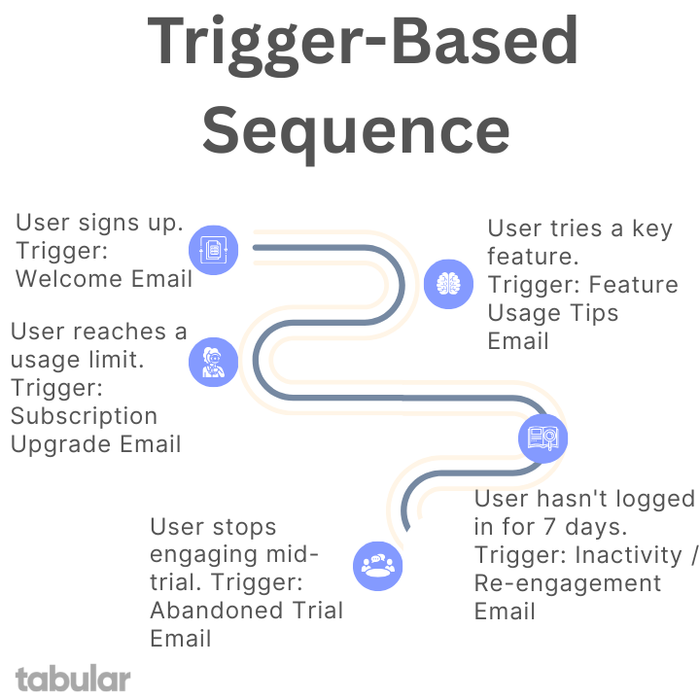
Differences from Regular Email Sequences
- Event-driven: Sent in response to specific actions (e.g., user signs up, abandons a trial, completes a milestone, or cancels a subscription).
- Highly personalized: Can include dynamic content based on user behavior, preferences, or actions.
- Immediate timing: Usually sent within minutes or hours after the triggering event.
- Goal-focused: Each email targets a very specific outcome—activation, conversion, upsell, or retention.
Examples of Trigger Emails for SaaS
- Welcome Trigger Email: Sent immediately after signup. Reinforces value and provides next steps.
- Feature Usage Trigger: When a user tries a key feature for the first time, guide them with tips or tutorials.
- Abandoned Trial/Feature Trigger: If a user stops engaging mid-trial, prompt them to return with tips, reminders, or incentives.
- Subscription Upgrade Trigger: When usage reaches a certain threshold, suggest a plan upgrade or add-on.
- Inactivity or Churn Trigger: Detect inactive users and send a personalized re-engagement email.
Why Include Trigger Emails in SaaS Marketing
- Increases open and click rates because emails are relevant to immediate user behavior.
- Encourages faster product adoption by providing timely guidance.
- Reduces churn by re-engaging users at risk of leaving.
- Complements existing timed sequences, creating a more intelligent and responsive email ecosystem.
Customer Feedback and Testimonial Email Sequences for SaaS Companies
Customer feedback and testimonial email sequences for SaaS companies are designed to gather user opinions and reviews, build trust through social proof, and improve the product experience while fostering strong customer relationships. These sequences typically include a few well-timed, personalized emails to encourage participation and show appreciation.
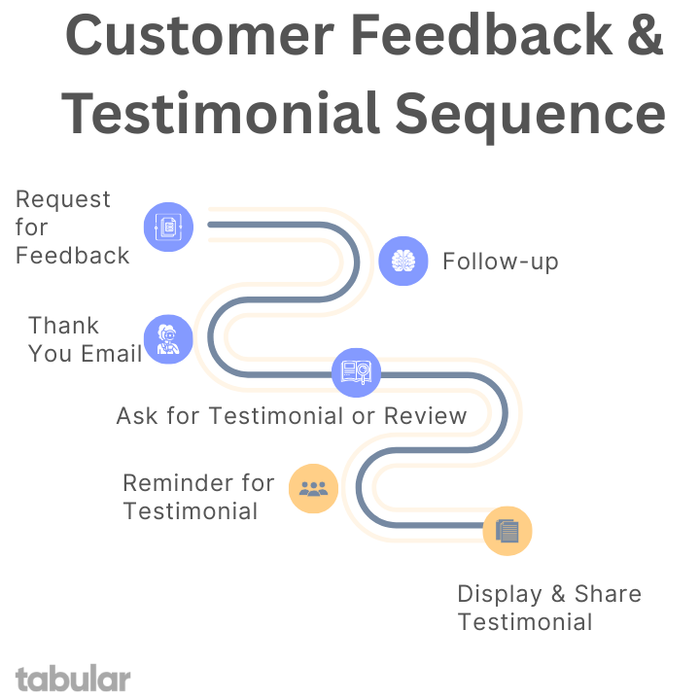
Typical Customer Feedback Email Sequence
1. Request for Feedback
- Ask for input on their experience using the product.
- Include easy-to-complete surveys, Net Promoter Score (NPS), or quick rating systems embedded in the email to boost response rates.
- Example: “How is [Product] working for you? We’d love your feedback!”
2. Incentivize Feedback
- Send a follow-up offering an incentive such as a discount, exclusive content, or entry into a giveaway to motivate more responses.
- Personalize so that the offer feels special and exclusive.
3. Acknowledgement and Thank You
- Thank users for their feedback.
- If negative feedback was received, mention any planned improvements or how their input will be acted on.
- Reinforce that their voice matters for product evolution.
Testimonial/Social Proof Collection Sequence
1. Ask for Testimonial or Review
- After customers have had positive engagement or success with the product, request a testimonial or online review.
- Make it easy with direct links to review platforms or a simple reply option.
2. Reminder Email
- Gently remind users who haven’t responded to share their testimonial.
- Illustrate the value of their story to the company and future customers.
3. Display and Share Testimonials
- Let users know their testimonials will be featured on your website or marketing materials.
- Thank them and reinforce the partnership.
Best Practices
- Keep emails concise, polite, and user-focused.
- Embed interactive elements like rating stars or emojis to gather quick feedback with minimal effort.
- Personalize based on customer history or usage patterns.
- Space emails appropriately to avoid fatigue while maintaining engagement.
- Show appreciation genuinely to foster loyalty.
This feedback and testimonial email sequence not only helps SaaS companies collect valuable user insights for product improvement but also builds trust and credibility through authentic social proof.
The 3-2-1 Email Method and How to Use It in SaaS Email Sequences
The 3-2-1 email method is a simple and effective way to structure communication, often used in onboarding or marketing emails. It is designed to guide recipients through a clear set of next steps or pieces of information. The method involves presenting:
- 3 actionable items or ideas
- 2 supporting points or quotes
- 1 question or call to action
This format makes content easy to digest and encourages engagement by breaking down complex information into manageable parts.
Example of Using 3-2-1 in a SaaS Onboarding Email
- 3 steps the user should take next: complete profile, integrate account, download the app
- 2 benefits of using the product or tips to overcome common challenges
- 1 question inviting the user to reply or engage: “What can we help you with today?”
Core Value of the 3-2-1 Method
- Provides simplicity and actionable clarity, making it straightforward for the recipient to know exactly what to do next.
- Often paired with visual elements to reduce user anxiety and increase completion rates.
- Praised for making communication clear and manageable, often summarized as “easy as 1-2-3” to help build momentum in user engagement during trials or signups.
This method can be applied across SaaS email sequences—onboarding, trial-to-customer, and feature announcements—to structure messages effectively and drive action without overwhelming the recipient.
Best Practices for SaaS Email Marketing Sequences in 2025
Best practices for SaaS email marketing sequences in 2025 focus on personalization, automation, clear communication, and customer-centric approaches to nurture leads, engage users, and drive conversions effectively.
1. Segment Your Audience
- Segment email lists based on customer journey stages (new users, trial users, active users, power users, churned customers).
- Tailor email content and offers to each segment’s specific needs and pain points.
2. Personalize Every Email
- Use personalized fields like name, company, role, and usage data.
- Customize content based on user behavior, preferences, and past interactions.
- Use dynamic content blocks to address individual needs.
3. Automate with Trigger-Based and Time-Based Sequences
- Implement trigger-based sequences responding to user actions (signups, feature usage, inactivity).
- Use time-based sequences for onboarding, nurture, renewals, and re-engagement.
- Employ conditional logic to adjust sequences based on engagement.
4. Craft Clear, Concise, and Actionable Content
- Focus each email on a single clear goal or call to action (CTA).
- Write compelling subject lines that spark curiosity and urgency without clickbait.
- Use simple, jargon-free language that resonates with the audience.
5. Use Visuals and Mobile-Optimized Design
- Include relevant images, GIFs, or videos to make emails visually appealing.
- Ensure emails are mobile-friendly since many users access emails on their phones.
6. Provide Value and Build Trust
- Share educational content, success stories, social proof, and practical tips.
- Reinforce product benefits and address common objections.
7. Space Out Emails to Avoid Overwhelm
- Allow time between emails for users to engage without feeling spammed.
- Monitor engagement and adjust frequency as needed.
8. Test, Measure, and Optimize
- Use A/B testing for subject lines, content, CTAs, and send times.
- Track open rates, click-throughs, conversions, and unsubscribe rates.
- Continuously refine sequences based on data insights.
9. Integrate with CRM and Customer Data Platforms
- Sync email marketing with CRM to enable unified customer profiles.
- Use insights from sales and support teams to guide email content strategy.
10. Be Transparent and Respectful
- Clearly state why users are receiving emails.
- Offer easy unsubscribe options.
- Respect privacy and data protection regulations.
Popular email sequences SaaS companies focus on include welcome/onboarding, trial nurture, lead nurturing, renewal reminders, upsell/cross-sell, re-engagement, and customer feedback requests.
Following these practices ensures SaaS companies deliver timely, relevant, and personalized communication that converts leads into loyal customers while enhancing the overall user experience.
Final Words
While the strategic implementation of targeted email sequences is an indispensable tool for driving growth and reducing churn, their ultimate effectiveness depends entirely on the strength of your brand image and the quality of the connections you build with your users.
In order to successfully run these SaaS email sequences, you'll need a number of email templates such as welcome emails, account verifications, and even newsletters. The hardest part is designing the emails you use—writing the HTML with overly strict dependencies for different service providers and clients, creating professional and high-converting emails, and testing them along the way is a whole challenge on its own. You can simplify this process using Tabular.
Tabular is a drag-and-drop email builder with a modern and easy-to-use interface. You can find more than a thousand pre-made modules to use in your SaaS email templates, test different parts of your designs, and generate clean HTML that works in every client without issues. Thanks to Tabular, you can integrate it with major ESPs, including HubSpot, Mailchimp, and Klaviyo, to use your templates easily across platforms.
Tabular is a great choice for any SaaS company that wants to communicate with its users in a professional and brand-consistent manner.